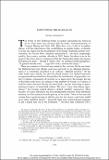Files in this item
Reinventing the barbarian
Item metadata
| dc.contributor.author | Harrison, Tom | |
| dc.date.accessioned | 2021-04-01T23:40:39Z | |
| dc.date.available | 2021-04-01T23:40:39Z | |
| dc.date.issued | 2020-04 | |
| dc.identifier | 252041287 | |
| dc.identifier | e7c65f5f-2f1f-43bd-b797-252e64179f3a | |
| dc.identifier | 85083279262 | |
| dc.identifier | 000523682200001 | |
| dc.identifier.citation | Harrison , T 2020 , ' Reinventing the barbarian ' , Classical Philology , vol. 115 , no. 2 , pp. 139-163 . https://doi.org/10.1086/708032 | en |
| dc.identifier.issn | 0009-837X | |
| dc.identifier.other | ORCID: /0000-0003-1968-9859/work/72842303 | |
| dc.identifier.uri | https://hdl.handle.net/10023/21759 | |
| dc.description.abstract | Since the publication of François Hartog’s Le Miroir d’Hérodote, Edith Hall’s Inventing the Barbarian, and a flurry of subsequent works, there has been a marked backlash against the Barbarian in classical scholarship. The theme of Greek–Barbarian polarity has been seen as a narrowly Athenian phenomenon, irrelevant to other regional contexts. Scholars have increasingly presented evidence of contact with, or borrowings from, non-Greek cultures, on the assumption that these are incompatible with the rhetoric of polarity. This article questions some of the central assumptions of this scholarly trend, exploring possible explanations for it, and proposes that the Barbarian still should have currency. | |
| dc.format.extent | 590969 | |
| dc.language.iso | eng | |
| dc.relation.ispartof | Classical Philology | en |
| dc.subject | PA Classical philology | en |
| dc.subject | Arts and Humanities(all) | en |
| dc.subject | NDAS | en |
| dc.subject | BDC | en |
| dc.subject | R2C | en |
| dc.subject.lcc | PA | en |
| dc.title | Reinventing the barbarian | en |
| dc.type | Journal article | en |
| dc.contributor.institution | University of St Andrews. School of Classics | en |
| dc.identifier.doi | 10.1086/708032 | |
| dc.description.status | Peer reviewed | en |
| dc.date.embargoedUntil | 2021-04-02 |
This item appears in the following Collection(s)
Items in the St Andrews Research Repository are protected by copyright, with all rights reserved, unless otherwise indicated.

